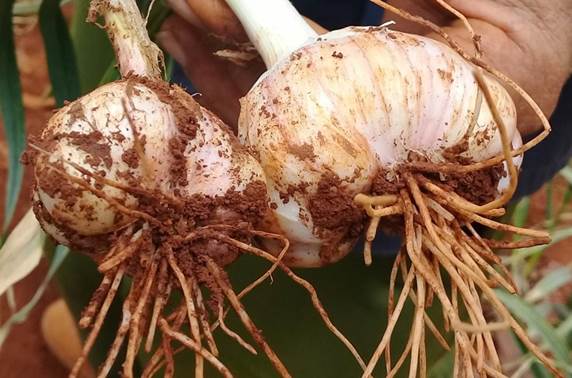Mi SciELO
Servicios Personalizados
Articulo
Indicadores
-
 Citado por SciELO
Citado por SciELO
Links relacionados
-
 Similares en
SciELO
Similares en
SciELO
Compartir
Cultivos Tropicales
versión On-line ISSN 1819-4087
cultrop vol.42 no.4 supl.1 La Habana 2021 Epub 30-Dic-2021
Report of new cultivar
'Fredy', a new garlic genotype introduced in Cuba
1Facultad de Ingeniería y Ciencias Empresariales. Universidad de Artemisa (UA), calle 8C No. 713 entre 7 y Campo, Abraham Lincoln Artemisa, Artemisa. Cuba
2Instituto Nacional de Ciencias Agrícolas (INCA), carretera San José-Tapaste, km 3½, Gaveta Postal 1, San José de las Lajas, Mayabeque, Cuba. CP 32 700
3Universidad Agraria de La Habana “Fructuoso Rodríguez Pérez”, carretera a Tapaste y Autopista Nacional, San José de las Lajas, Mayabeque, Cuba. CP 32 700
4Finca-Escuela “La Rebeca”. Cooperativa de Créditos y Servicios (CCS) “Niceto Pérez”, Güira de Melena, Artemisa, Cuba
The elephant garlic (Allium ampeloprasum L.) was introduced in Cuba, but it is not known who brought it. It is adapted to production and climatic conditions in the western part of the country, between October and February. With low inputs, it is resistant to diseases and reaches yields higher than 24.89 t ha-1 when planting is done mechanized and the "seed" is planted at 0.70 m of row, two rows and 0.07 m between plants, with which it reached between 15.10-15.0 t ha-1. This new garlic species has good post-harvest quality and adaptability in the areas studied.
Key words: Allium ampeloprasum; postcosecha; semilla; rendimiento
INTRODUCTION
In Cuba, garlic production is based on Criollo and Vietnamese clones, whose yields range between 4-9 t ha-1, with average values of 6 t ha-1, but bulbs that have been obtained are generally of small size and large number of fine "cloves", whose yields are low when compared with those of other producing countries. This species is of great economic importance, since its demand by the population is growing every day; however, due to difficulties encountered in crop, numerous efforts and research are being made to obtain new cultivars and introduce genotypes that are better adapted to the soil and climatic conditions of the country, with high productivity and good post-harvest quality of the "seed".
ORIGIN
It is introduced from abroad to the country through the locality "El Mamey", Güines municipality, Mayabeque province in 2016, from there it was disseminated to Batabanó, Güira de Melena and Alquízar, municipalities belonging to the province of Artemisa. It has always been called elephant's foot garlic or simply elephant garlic and it has been selected for the size of the bulb, the "tooth" and its productivity for more than three years.
GENOTYPE DESCRIPTION
(Fredy( is a genotype that plant presents a much more robust appearance than the Criollo and Vietnamese garlic, in general, with a height of more than 54 cm, it presents 6-12 linear leaves, 1-2 cm wide, flat and drooping; the bulb is large and can reach between 47.0-50.80 mm in equatorial diameter (Figure 1); it is propagated through the "cloves", it presents between 8-10 large "cloves", white-creamy in color and it is the means by which this genotype of elephant garlic is propagated in Cuba. The average monthly temperatures for growth ranged between 24-27 ºC (2 ºC) and for bulb formation and harvest between 23-25 ºC (2 ºC). This genotype was not affected by diseases that influence lower productivity and "seed" quality of the genus Allium. It can be extremely variable, with different temperature requirements; if temperatures are very low during the vegetative phase (below 20 ºC), the number and height of the leaves are affected, and if temperatures are extreme during the night (below 12 ºC), the number and size of the "cloves" are affected and consequently the translocation of assimilates from the leaves to the bulb, so the bulb size is affected and, consequently, the yield and quality of the crop are also affected.
Its biological cycle, in other countries (Mexico, Spain, and Argentina) ranges between 180-240 days (6-8 months) and emits a floral scape, which is cut or tied so that nutrients are concentrated in the bulb. In its cycle it is reduced to 4-5 months [120-150 days] (October-February) and does not emit a floral scape. It presents good agronomic characteristics and has adapted to the production conditions in the different agroecosystems in which it was evaluated, such as: "La Guajira" Farm in Boyeros municipality, Havana province, "La Yerena" Farm, Batabanó municipality, Mayabeque province and "La Rebeca" Farm, Güira de Melena municipality, Artemisa province. This is a genotype that presents genetically stable characters in the localities studied, which are listed below:
Height of the foliage of the plant (cm): 54-2
Number of leaves: 9-12
Bulb mass (g): 44,04-48,42
Bulb polar diameter (mm): 47,80-50,80
Polar bulb diameter (mm): 38.00-39.50
Number of "teeth" per bulb: 8-10
Mass of the "cloves" (g): 4.7-4.99
Yield (t ha-1): 24.89-25.0
Visible symptoms of viral, fungal or bacterial diseases: none observed
Post-harvest seed quality during storage: very good
Biological cycle (days): 120-150
Received: October 18, 2021; Accepted: November 23, 2021











 texto en
texto en 



